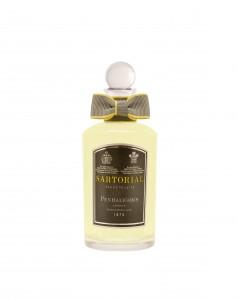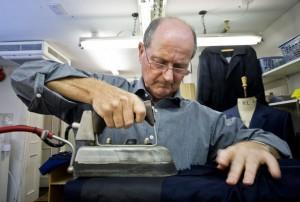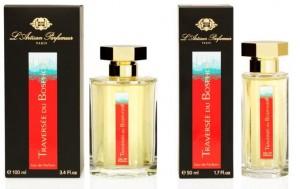One of the most interesting answers from Michelyn Camen’s Interview with Bertrand Duchaufour, for me, was the following exchange:
MC: Which comes first in developing a perfume…..the sense of location, of place, or an idea?
BD: Location can be a pretext or I can get a concept before picking a location. I can work both ways, first of all idea to choose a few words or a concept….for example one of duality. For example, I was in Japan two weeks ago and I got the idea of doing something around rice and black ink. It’s a good concept.
It had never occurred to me that M. Duchaufour worked with a central duality with which he then adds in the rest. His fragrances like L’Artisan Parfumeur Timbuktu always seemed like olfactory travelogues capturing a place. But in retrospect the woodsmoke and incense that hang over the entire development, of that fragrance, are the hub of each of his fragrances. In the two latest releases by M. Duchaufour, Penhaligon’s Sartorial and L’Artisan Parfumeur Traversee du Bosphore, it is very clear what the central duality at play is and both of these are good examples of M. Duchaufour’s duality design aesthetic.
Penhaligon’s Sartorial
Also in Ms. Camen’s interview, M. Duchaufour described his visit to a Savile Row tailor to describe what the duality was he was trying to evoke; “I tried to capture this unique ambiance in the fragrance—from the dust on the wood of the antique furniture, to the British leather club chairs where customers were waiting to try on a suit. I was intrigued by the fabrics, especially the effects of the iron’s steam on the fabrics; the presence of steam is everywhere.” Here the duality comes from the juxtaposition of the smell of a steam iron on fabric and old wood. The other pieces of a tailor’s shop are represented but the central duality is that smell of freshly pressed fabric still holding a hint of steam with the age of the wood cabinetry.
The opening of Sartorial contains a wet ozonic accord to start and if I was sniffing this completely blind I would think Sartorial was headed to the beach and not Savile Row. Because I did know what M. Duchaufour was going for I was very surprised by its presence it is the one part of Sartorial that feels out of place. Sartorial heads for traditional fougere territory very quickly, after the ozone appears, as with violet leaf M. Duchaufour conjures up the metal of the iron as we head into the metaphorical tailor’s shop. Lavender and linden usher us past the well-to-do gentleman wearing his lavender water waiting in the leather chair. All of this is kept light and develops quickly as Sartorial almost seems to be in a race to get to the base and the money shot. That comes as we enter the backroom with the tailor ironing the final creases into the suit steam swirling around the smell of heated fabric. Paired with this is the smell of the wooden shelves all around. The notes of gurgum wood, patchouli, myrrh and cedarwood are used to create this old wood effect. If Sartorial developed quickly to get here once it reaches the base it allows a slow, languid development as eventually the steam and fabric turn in to a sheer amber and allow for Sartorial to end softly.
L’Artisan Parfumeur Traversee du Bosphore
Traversee du Bosphore is inspired by M. Duchaufour’s visit to Istanbul and according to the press release his early morning walks along the Bosphorous. According to his interview with Ms. Camen the duality he was going for was described thusly; “So I spent ten days over there, to find the best pretext for something that was Oriental but different from the traditional Oriental notes. In creating this perfume, for me, it was very important to show duality. The leather contrasted with the Turkish Delight is a very important element of this fragrance.”
More so than in Sartorial the leather and Turkish Delight duality come to the foreground from the opening moments as rich leather wafts up along with an equally strong tobacco note. It is soon joined with saffron and cardamom as the spice milieu is kept on the light side. There is an apple note described in the note list and it is a frustrating note as I get it very strongly on a strip or fabric but not on my skin. Robin of Now Smell This also had the same experience and I am wondering if on different skin types it will be more prominent. I like it when I can smell it and it is a tart counterpoint to the rich sweetness surrounding it, when you can smell it. The leather has now refined itself into soft suede and now the Turkish Delight (Loukhoum) arrives. For those who like the various Loukhoum fragrances by Serge Lutens, Keiko Mecheri, or Ava Luxe you will know what to expect as the nutty rosewater confection arises out of the leather to offer, in the latter stages, a gourmand fragrance as it turns sweeter and nuttier in the closing.
Penhaligon’s Sartorial and L’Artisan Parfumeure Traversee du Bosphore have excellent longevity and above average sillage.
In both Sartorial and Traversee du Bosphore M. Duchaufour’s keen sense of location is firmly at work as both evoke Savile Row and Istanbul very nicely. I like both of them and will happily wear both of them but it is the morning walk on the banks of the Bosphorous that I believe I’ll be returning to more often but there will also be occasions to want to wear a fragrant bespoke suit and Sartorial is going to be my choice, then.
Disclosure: This review was based on preview bottles provided by Penhaligon’s and L’Artisan Parfumeur.
-Mark Behnke, Managing Editor





